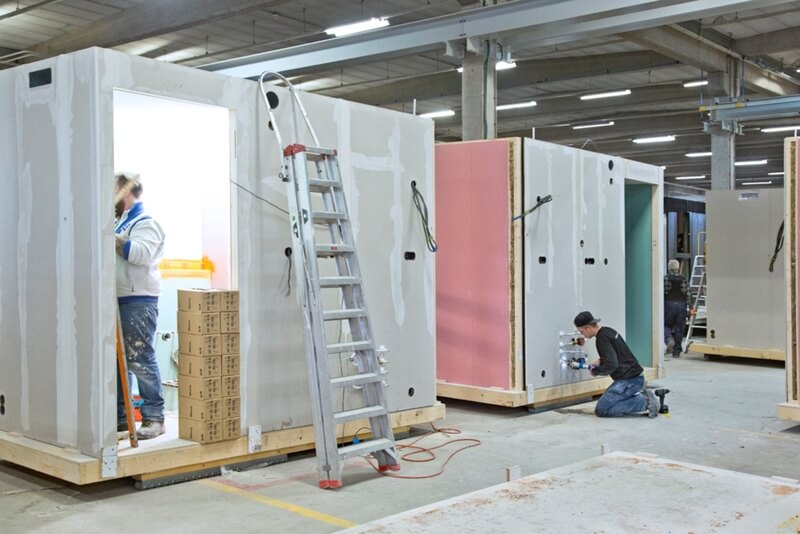Sustainable and Efficient: How Modular Buildings are Changing the Game
One of the most notable advancements in the field of sustainable and efficient construction methods is the rise of modular buildings. These innovative structures are changing the game by offering sustainability, efficiency and numerous other benefits over traditional construction methods.
In recent years, there has been a growing interest in sustainable and efficient construction methods. One approach that is gaining traction is the use of prefab modular buildings. These innovative structures are changing the game by offering numerous benefits. In this article, we highlight two of those benefits that are closely tied together: sustainability and efficiency.
Prefabrication, Modular Buildings and Sustainability
In recent years, there has been a growing concern about the impact of traditional construction methods on the environment. From excessive waste generation to high energy consumption, the construction industry has long been considered one of the major contributors to environmental degradation. However, with the rise of modular construction, there is hope for a greener tomorrow.
Prefab construction involves building structures off-site in factory-controlled conditions and then transporting them to their final location for assembly. This innovative approach offers numerous environmental benefits that are worth exploring:
- Reducing Waste Generation
- Reducing Energy Consumption
- Reducing Transportation Needs
- Easier Adaptation to Changes
- Opportunities for Sustainable Design Integration
- Promoting Recycling of Materials
In the following, we delve more precisely on these benefits.
Reducing Waste Generation
Modular construction significantly reduces waste generation. Traditional construction projects often produce large amounts of waste due to inaccurate measurements, over-ordering materials, and onsite errors. In contrast, prefabricated modules are built with precision in controlled environments where waste can be minimized through careful planning and efficient use of resources. Moreover, any leftover materials from module production can be recycled or repurposed rather than ending up in landfills.
Reducing Energy Consumption
Factory-controlled environment of prefabrication process allow better insulation and sealing techniques that minimize heat loss or gain compared to traditional onsite construction methods. This translates into lower energy requirements for heating or cooling buildings once they are occupied. As a result, modular construction reduces energy consumption during both manufacturing and installation processes.
Reducing Transportation Needs
Because modules are constructed off-site using standardized designs and materials, there is less need for transportation during the building process. Traditional construction often requires multiple deliveries of materials to the site which contribute to carbon emissions from trucks or other vehicles used for transportation. Prefabricated modules are transported only once when they are ready for assembly at their final destination.
Easier Adaptation to Changes
Moreover, modular buildings have inherent flexibility that allows them to adapt easily to changing needs without demolition or extensive renovations. This means fewer resources consumed over time as buildings can be modified or expanded by simply adding or removing modules as required.
Opportunities for Sustainable Design Integration
Another significant advantage of modular buildings are their potential for sustainable design integration. With the growing emphasis on sustainable living, modular construction allows for the incorporation of eco-friendly features such as solar panels, rainwater harvesting systems, and energy-efficient appliances right from the start. This ensures that buildings are not only environmentally friendly but also provide long-term cost savings to occupants.
Promoting Recycling of Materials
Lastly, modular construction promotes sustainability by encouraging the reuse and recycling of materials. As modules can be disassembled and repurposed elsewhere if needed, there is less waste generated during demolition or renovation processes. This approach aligns with the principles of sustainability and resource conservation.

Image: Ursem
Modular Buildings and Efficiency
Efficiency is an another crucial factor in any construction project. Time is money, and delays can have significant consequences. Prefabricated buildings can promote efficiency of construction projects with many ways:
- Streamlining Processes
- Enablement of Parallel Workflows
- Enhanced Quality Control
- Advanced Versatility and Flexibility
Let’s focus more on these benefits next.
Streamlining Processes
One key advantage of prefabricated modular buildings is their ability to streamline the construction process. Since these structures are manufactured in controlled environments, there is no need to worry about weather conditions or other external factors that could delay progress. Construction can continue uninterrupted regardless of rain, snow, or extreme temperatures.
Enablement of Parallel Workflows
The modules are manufactured simultaneously while site preparation takes place, allowing for parallel work streams that significantly expedite the overall project timeline.
Enhanced Quality Control
Due to their factory-controlled production process, prefab modules undergo rigorous quality control checks at every stage of manufacturing. This ensures that each module meets strict industry standards before being transported to the final site for assembly. As a result, these buildings have higher structural integrity and durability than traditionally constructed ones.
Advanced Versatility and Flexibility
The versatility and flexibility should not be overlooked either, when discussing efficiency of prefab modular buildings. They can be customized to suit various purposes including residential homes, office spaces, schools or healthcare facilities. With endless design possibilities available today – from contemporary aesthetics to more traditional styles – these structures can seamlessly blend into any environment.
Through versatile use cases, modular buildings offer flexibility when it comes to relocation or expansion needs. As they are designed with modularity in mind, additional modules can be easily added or removed as required. This adaptability allows businesses and individuals to scale their spaces according to changing needs, without the hassle and cost associated with traditional construction.
Conclusion
Prefab and modular buildings are revolutionizing the construction industry by providing sustainable and efficient alternatives to traditional building methods. Their reduced environmental impact, shorter construction time, enhanced energy efficiency, and flexibility make them an attractive choice for those looking for innovative solutions in today’s rapidly evolving world. As more people recognize the benefits of these structures, we can expect to see a significant shift towards modular buildings as the new standard in construction practices.
Read more how what is Vertex BD’s role in prefabrication and how it can speed up your projects.

